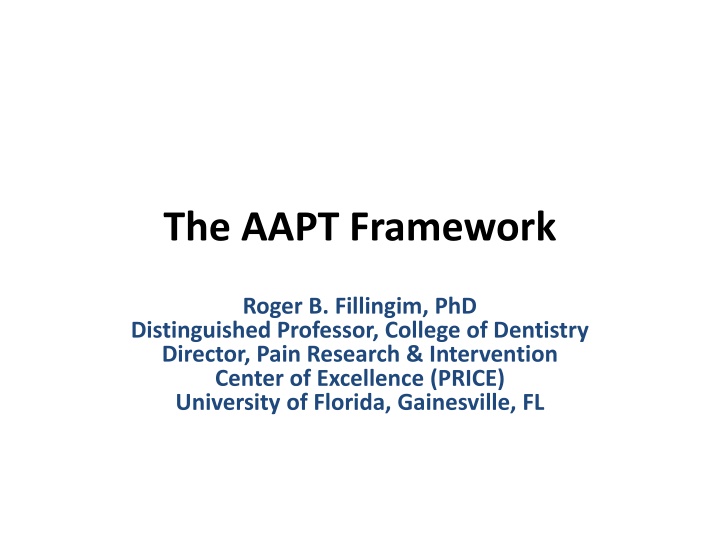The AAPT Framework
AAPT Framework led by Roger B. Fillingim, PhD, aims to advance understanding and treatment of chronic pain through the development of a comprehensive pain taxonomy. The timeline spans from initial email communications to the publication of foundational articles. The goal is to establish clear diagnostic criteria for chronic pain conditions, facilitating research, clinical trials, and regulatory processes.
Download Presentation

Please find below an Image/Link to download the presentation.
The content on the website is provided AS IS for your information and personal use only. It may not be sold, licensed, or shared on other websites without obtaining consent from the author.If you encounter any issues during the download, it is possible that the publisher has removed the file from their server.
You are allowed to download the files provided on this website for personal or commercial use, subject to the condition that they are used lawfully. All files are the property of their respective owners.
The content on the website is provided AS IS for your information and personal use only. It may not be sold, licensed, or shared on other websites without obtaining consent from the author.
E N D
Presentation Transcript
The AAPT Framework Roger B. Fillingim, PhD Distinguished Professor, College of Dentistry Director, Pain Research & Intervention Center of Excellence (PRICE) University of Florida, Gainesville, FL
Overview of Presentation Brief history of AAPT Conceptual considerations Current framework Future activities
Timeline DATE ACTIVITY September, 2012 Initial email from ACTTION to APS proposing partnership October, 2012 Initial approval from APS Board (formal approval 1/13); Announcement of AAPT in ACTTION Newsletter October, 2012 April, 2013 Planning for AAPT Launch Meeting April, 2013 Article on AAPT posted on Pain Research Forum May, 2013 AAPT Launch Meeting May October, 2013 Working group Chairs identified and working groups formed November, 2013 AAPT Framework article submitted to J Pain January, 2014 Manuscript accepted January July, 2014 Working groups meeting and beginning their work July, 2014 Second AAPT Meeting July, 2014-present Working groups developing diagnostic criteria September, 2016 JOP Supplement of foundational articles to be published
Initial eMail from Bob Among the activities that ACTTION is undertaking to advance understanding and treatment of acute and chronic pain is the development of a comprehensive, coordinated, evidence-based, and up-to-date pain taxonomy classification scheme. A comprehensive pain taxonomy is essential so that consistent and accurate diagnoses are used for clinical research, clinical trials, and to facilitate comparisons across studies for systematic reviews and meta-analyses. A standardized classification system is also critical for regulatory reviews of new drug applications. At present, there is no consensus on pain classification. This shortcoming has impeded the development of improved treatments by the lack of clear diagnostic criteria being available.
AAPT LAUNCH MEETING MAY 17-18, 2013
Goal To develop a framework that all working groups could apply in developing diagnostic criteria for chronic pain conditions.
Agenda Person(s) Topic Chuck O Brien Evolution of DSM Pat Mantyh & Frank Porreca How Can Chronic Pain Mechanisms Inform the Classification of Chronic Pain Conditions? Sam Dworkin Developing Research and Clinical Diagnostic Criteria for Temporomandibular Disorders and Facial Pain Eva Widerstrom-Noga Developing Diagnostic Criteria for Spinal Cord Injury Pain Steve Bruehl Developing Diagnostic Criteria for Complex Regional Pain Syndrome Roger Fillingim Proposals for a Multi-axial Framework for a Chronic Pain Taxonomy All Attendees Group Discussion: Toward Consensus on an Evidence-based Classification of Chronic Pain All Attendees Working Groups, Deliverables, Deadlines
Upcoming JOP Supplement 1. Multidimensional diagnostic criteria for chronic pain: Introduction to the ACTTION-American Pain Society Pain Taxonomy (AAPT) - Bob Dworkin, Steve Bruehl, Roger Fillingim, John Loeser, Greg Terman, and Dennis Turk 2. Assessment of pain-related symptoms and signs - Roger Fillingim, Ralf Baron, John Loeser, Rob Edwards 3. Assessment of psychosocial and functional impact, including sleep - Dennis Turk, Roger Fillingim, Richard Ohrbach, Kushang Patel 4. Life span developmental considerations in the diagnosis of chronic pain Gary Walco, Elliot Krane, Kenneth Schmader, Debra Weiner 5. Pathophysiologic mechanisms and their identification Daniel Vardeh, Richard Mannion, Clifford Woolf 6. Psychosocial mechanisms and their identification - Rob Edwards, Mark Sullivan, Dennis Turk, Ajay Wasan 7. Overlapping chronic pain conditions and their implications for diagnosis and classification - William Maixner, Roger Fillingim, David Williams, Shad Smith, Gary Slade 8. Approaches to developing the evidence base for a multi-dimensional pain taxonomy - Steve Bruehl, Richard Ohrbach, Sonia Sharma, Eva Widerstrom-Noga, Bob Dworkin, Roger Fillingim, Dennis Turk
Overview of Presentation Brief history of AAPT Conceptual considerations Current framework Future activities
Disorder, Disease, and Diagnosis Description Comments Disorder A medical concern in a patient, an abnormality, injury, or aberration. Generally used when the pathological process is unknown. Disease A known pathological process that leads to one or more disorders. A disorder may reflect multiple diseases, and vice versa. Diagnosis A procedure used to decide whether or not a certain disorder or disease is present is a patient. A disorder or disease is a characteristic of the patient; a diagnosis is an opinion that the disorder or disease is present. Kraemer, et al., 2007, Soc Psychiatry Psychiatr Epidemiology, 42: 259-67
What is the Purpose of Diagnosis? TO GUIDE TREATMENT & PROGNOSE Secondary purposes Satisfy patient curiosity/legitimate symptoms Research purposes Billing
Lumping vs. Splitting The open question is whether different diagnostic manifestations of a basic pathological process have been divided into multiple diagnostic silos, creating artifactual comorbidity in certain circumstances. Stephen E. Hyman (2011). Diagnosis of Mental Disorders in Light of Modern Genetics. In (Regier, et al., Eds). The Conceptual Evolution of DSM-5. Amer Psychiatric Publishing: Arlington, VA.
Chronic Overlapping Pain Conditions (COPCs) www.chronicpainresearch.org
Characteristics of an Ideal Diagnostic System Biological plausibility Exhaustive Mutually exclusive Reliable Clinically Useful Simple
Pre-AAPT State of Pain Classification Multiple diagnostic systems proposed by different groups with no uniformity of structure or approach Most have limited evidence supporting reliability or validity Based primarily on signs and symptoms, which can overlap considerably Diagnostic studies usually emphasize tissue damage, which has at best a modest association with pain Pain diagnoses typically provides limited information regarding the mechanisms underlying the pain experience.
Major Points of Discussion at Launch Meeting Should AAPT Be Evolutionary or Revolutionary (i.e. How Mechanism-Based Can We Make It)? How Should Chronic Pain Disorders be Categorized?
Etiology Versus Mechanisms Etiology General Mechanisms Specific Mechanisms Diabetic peripheral neuropathy Diabetes- induced nerve damage Peripheral nerve damage, altered central pain processing TRP channels Knee Osteoarthritis Changes in the knee joint Peripheral inflammation & mechanical nociception, Central sensitization Specific cytokines, matrix metalloproteinases Fibromyalgia Infection, trauma, unknown Central and/or peripheral sensitization Altered serotonergic function
Major Points of Discussion at Launch Meeting Should AAPT Be Evolutionary or Revolutionary (i.e. How Mechanism-Based Can We Make It)? How Should Chronic Pain Disorders be Categorized?
Peripheral & Central Nervous Systems - Peripheral Neuropathic Pain - Central Neuropathic Pain Musculoskeletal Pain System - Osteoarthritis - Other Arthritides (e.g. Rheumatoid Arthritis, Gout, Connective Tissue Diseases) - - - Musculoskeletal Low Back Pain Myofascial Pain, Chronic Widespread Pain, and Fibromyalgia Other Predominantly Musculoskeletal Pain Orofacial & Head Pain System - Headache Disorders* - Temporomandibular Disorders - Other Orofacial Pain Visceral, Pelvic & Urogenital Pain - Visceral Pain: Abdominal, Pelvic, and Urogenital Pain Disease-Associated Pains Not Classified Elsewhere - Cancer Pain - Pain Associated with Sickle Cell Disease
Important Characteristics of AAPT Evidence-based Systematically applied across pain conditions Multidimensional and biopsychosocial Applicable for both research and clinical use Should evolve based on new evidence
DIMENSION DESCRIPTION Includes symptoms and signs required for diagnosis of the disorder (e.g. periauricular pain, palpation sensitivity, joint sounds in the case of TMD). Also includes diagnostic tests and differential diagnosis considerations. Core Diagnostic Criteria Provides additional information regarding the disorder, including common pain characteristics (e.g. location, temporal qualities, descriptors), non-pain features (numbness, fatigue), and the epidemiology of the disorder. These features are helpful in describing the disorder but are not used as part of the diagnosis. Common Features Includes medical diagnoses that co-occur with high frequency with the pain disorder. For example, diabetes mellitus is often comorbid with osteoarthritis, and major depression is comorbid with many chronic pain disorders. Common Medical Comorbidities Includes information regarding neurobiological and psychosocial consequences of chronic pain, as well as the functional impact of the pain disorder. Examples include, allostatic load, sleep quality, mood/affect, coping resources, physical function, and pain-related interference with daily activities Neurobiological, Psychosocial and Functional Consequences Putative Neurobiological and Psychosocial Mechanisms, Risk Factors & Protective Factors Includes putative neurobiological and psychosocial mechanisms contributing to the pain disorder, including potential risk factors and protective factors.
AAPT Chronic Pain Diagnostic Criteria (being submitted to Journal of Pain as 9 individual manuscripts) Peripheral and Central Nervous Systems 1. Peripheral neuropathic pain (CRPS; PHN; post-traumatic/post-surgical; trigeminal neuralgia; DPN, HIV, and idiopathic polyneuropathies) 2. Central neuropathic pain (post-stroke, spinal cord injury, MS) Musculoskeletal System 3. Spine pain, including radiculopathy and other neuropathic back pain conditions 4. Fibromyalgia and chronic myofascial and widespread pain 5. Arthritides/arthropathies (OA, RA, gout, spondyloarthropathies) Orofacial and Head Pain 6. Temporomandibular disorders Visceral, Pelvic, and Urogenital Pain 7. Abdominal, pelvic, and urogenital pain (IBS, IC, vulvodynia) Disease-associated Chronic Pain 8. Cancer pain (including pancreatic cancer pain, cancer-induced bone pain, chemotherapy- induced peripheral neuropathy) 9. Sickle cell pain
AAPT-I vs. AAPT-II AAPT-I: Diagnostic criteria based on available evidence from literature reviews, existing criteria, secondary data analyses, and expert consensus AAPT-II: Evidence-based revision of AAPT-I diagnostic criteria as a result of studies of their reliability and validity
Timeline DATE ACTIVITY mid 2016 early 2017 Submission and publication of diagnostic criteria in Journal of Pain: 9 open-access articles published separately early 2017 Launch meeting for AAPT-II research studies mid 2017 Publication of combined supplement and/or book
What Can Taken from AAPT and Applied to an Acute Pain Taxonomy? Evidence-based Systematically applied across pain conditions Multidimensional and biopsychosocial Applicable for both research and clinical use Should evolve based on new evidence
CHRONIC PAIN ACUTE PAIN?? Core Diagnostic Criteria Common Features Common Medical Comorbidities Neurobiological, Psychosocial and Functional Consequences Putative Neurobiological and Psychosocial Mechanisms, Risk Factors & Protective Factors





















